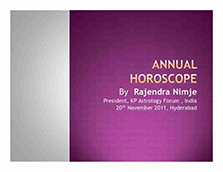Options Theory
Options Theory
Author: Rajendra
Published On: 18/08/2011
Krishnamurti Paddathi is a marvel propounded by our Guruji Prof Krishnamurti. It provides precise results for Natal charts and for horary questions. However, some time the question is difficult to cast in the pattern, ‘whether a particular event will take place or not?’ and if yes ‘when?’ Krishnamurti Paddathi perfection in time charts and horary number queries is undisputed but sometimes the choice is not binominal and there are many options. In such cases to find out which option will suit the client or which option he is likely to get in case of multiple choices is a challenge.
Options theory is based on the principle of ruling planets. As the option is a numerical choice, we need to pick up the correct option from a range of options. Ruling Planets is the master key of Krishnamurti Paddathi. Divine guidance never fails. Naturally, there must be is a way to convert these ruling planets to some number which can pinpoint the right option we are looking for. If we can convert the direction given by the ruling planets to a Ruling Planet number which will connect to the options then probably we can predict the right choice. Let us think about the fields of applicability of this theory.
Once I was working on a chart for a student who was interested in knowing whether he will pass or fail. For a KP astrologer it was an easy task. I considered the fourth house sub Lord and found connection with fourth and 11th and undoubtedly I predicted that he is going to pass. The next question he asked is whether he will get 60% or 70%. Now this was a tricky question and I could not able to answer with the KP horary knowledge I have. In another similar incident, I was working on the prospects of TDP government in 1999 elections in Andhra Pradesh. I casted the chart with the question in mind, whether TDP can form the government? This was a pretty simple case and I analyzed 6th and 11th sub lords in favor of TDP and 5th and 12th sub Lords in favor of Congress party. From the analysis of chart which was casted on 26th of August 1999 at 1704 hrs at Warangal the situation was clearly favorable to TDP to form a government. One of my officers was very curious to know the outcome and was insisting to find out how many seats TDP will get? Whether it will be a convincing the victory or it will be of thin margin case.
Certainly regular principles did not help. I came across some write up about the numerical use of ruling planets in a Marathi book1 I feel the appropriate name to this use of ruling planets for selection from a basket of options is ‘Options Theory’.
Methodology for Options Theory:
Take the ruling planets at the time of judgment without the rising star (Ascendant constellation lord)
1) Ascendant Lord
2) Moon starlord
3) Moon lord
4) Day lord
Ruling planets which are in the retro starlord will certainly not give the results and hence need to be taken out of our consideration. For remaining Ruling Planets, write-down the rasi numbers in front of the concerned starlord, rasilord or the day lord which they own.(In case of Rahu & Ketu take the rasi where they are deposited).Sum all the numbers noted against each one of them. If the total is more than a single digit then add up the digits to make it a single digit number(except in Rule 3). Subtract this single digit number in multiples from the total options till we get the remainder of a single digit. This remainder is the final choice which is indicated by the divine direction. I applied this theory to the problem in mind of finding out number of seats for the TDP party in 1999 general assembly elections.
Sometimes options are known and sometime the options are to be taken by us to reach a margin which is acceptable to the client. For example in a lottery there are 10 type of prizes and the client is interested to know which prize he will get then we need to find out which option is indicated by the ruling planets. On the other hand, in the present case we do not know the options. Election was announced for 293 seats and logically we can take 293 options. However, the client is interested in a range and not in the exact number of options. For example in a cricket match we might be interested in knowing what range of runs the batting side is likely to do? They are not interested in exact number of runs. Remember the question which was asked by the student was whether he will get 60% or 70%. Here there are two options, option one 60% and option two 70%. If we’re not sure whether he will really get 60% then we can add option less than 60%, if we do not know whether he can get more than 70% then we can add another option called as more than 70%. In that case we will have four options.
Case 1: How many seats TDP party will get in !999 assembly elections.
The officer has given me the range of following seats in assembly election for TDP
Option No. 1 225- 250 seats
Option No. 2 200- 225 seats
Option No. 3 175-200 seats
Option No. 4 150-175 seats
He was confident the party will not get less than 150 and more than 250 seats. The ruling planets were,
Ascendant Lord Saturn, Moon Lord Saturn, Moon starlord was Mars, and the day lord was Jupiter.
Saturn owns Capricorn and Aquarius i.e. 10th and 11th Rasis. Jupiter owns Sagittarius and Pisces, i.e. 9th of 12th rasis of the zodiac. Mars owns Aeries and Scorpio i.e. 1st and 8th rasis of the zodiac. Saturn was transiting in the Bharani constellation and the owner Venus was retrograde. Mars was transiting in Visakha constellation and the owner Jupiter was retrograde.
Ascendant Lord – Saturn ( In retro star)
Moon Star Lord – Mars ( In retro star)
Moon Lord – Saturn ( In retro star)
Day Lord – Jupiter = 9+ 12 =21
Hence, the ruling planets which can be considered for the options theory is only Jupiter. The total of Jupiter rasis is 21
As the total is more than 9 we can add the individual digits 2 and 1 making it 3
The third option is indicated as the resultant option is less than the total no. of options.
In the present case by the third option the TDP should get seats in the range of 175-200. In fact, TDP party won 180 seats in that election which is in the range of 175-200 as predicted by me. Options theory is successful.
As the single digit RP no. is less than the options the choice was straightforward. However, in few cases the choice is not that simple and the number of options may be more than single digit RP number or options may be less than the single digit RP number. In such cases there is a variation in the simple rule mentioned above. All the rules connected with the options theory are introduced below.
Rules- About Author:
1) If Options are 9 or less and the single digit RP no. is less than the no. of options then single digit no. indicate the correct option straightaway.
(Single Digit RP no







